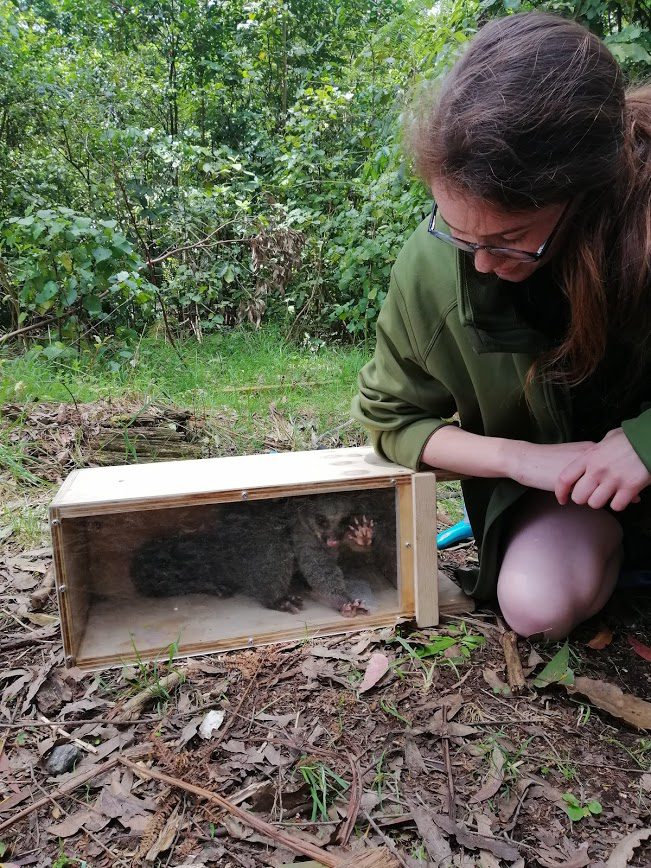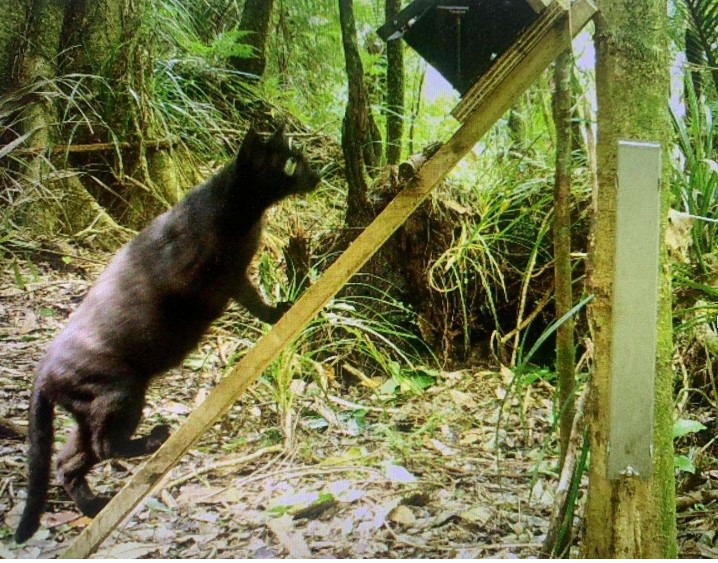Sharing our Stories

Taranaki Mounga Project is out and about sharing our stories. There’s been at least a dozen stories in the news media across multiple regional and national media organisations in the past year; The Taranaki Daily News, Radio New Zealand, TVNZ, Te Karere, Te Korimako and the Stratford Press. The stories have covered apprentices under DOC’s Jobs for Nature scheme, kiwi releases, calls for volunteers, appointment of new staff, working conservation dogs, translocations of species, 1080, and birds like the population of whio on the mountain doing well.
Our education and promotional efforts help explain what we are doing and why, raising awareness of the importance of restoring Taranaki Maunga and species like whio.
We continue to maintain a strong presence on social media as a way to highlight what we are doing and engage with the wider public. We have 5,390 followers. Our most popular posts are about people. One post about the study achievements of apprentices and rangers reached almost 6,000 people. This year we’ve been highlighting te reo Māori and te ao Māori perspective that’s an important part of our team and culture.
Thriving Whio

While 2022-23 was a tricky summer for monitoring whio, the population on the mounga is stable and there are increasing reports of the elusive native blue ducks beyond the park boundary.
DOC senior ranger Joe Carson says lots of rain and high rivers last summer made accessing and surveying this taonga species across 10 rivers on Mt Taranaki more of a challenge.
Current estimates are of 50-60 pairs of whio, regarded as a self-sustaining population. Two years ago a record 78 duckling whio were counted. It’s thanks to a big team effort between Te Korowai o Ngāruahine Trust, DOC and TMP in creating a network of 1100 traps on the mountain’s southern side, as well as 1080 operations.
Pouatawhi/lead ranger Tāne Houston says as the trapping network continues to provide safety margins in and along some of the rivers. “It’s allowing whio to spread through the river systems, where they are protected by traps.”
Joe says it’s heartening to hear increasing reports from trampers, farmers and members of the public who are seeing whio on their walks and in streams outside of the national park.
“Ten years ago people didn’t know what they were. Now when I go into schools, students tell me of sightings and where they’ve seen them and I have people calling in or sending images of them. Whio have been really adopted by Taranaki, we even have a whio rugby team.”
It’s a real success story as whio were classed as ‘functionally extinct’ from the maunga in 1945, due to introduced predators.
Possum behaviour helps inform predator trapping

Research into possum behaviour is helping inform predator control work on Taranaki Maunga.
Theo O’Malley’s research for her PhD – carried out between 2018 and 2021 and submitted last year, investigated predator behaviour, including the home range of possums and their interactions with different types of traps.
Theo found possums have a large variation in their home range, some ranging from 10 hectares while others were roaming up to 100 hectares. While the findings raise more questions, it’s helped predator control work, such as working out the minimum spacing of traps that works best for catching possums in areas where numbers of possums are low.
Theo also discovered possums had a low rate of interaction with two out of three types of traps. More interaction was occurring with leg hold traps and very little interaction with two other trap types. “The possums would often come up and engage with the traps and lick them for example. But in order to catch them they needed to put their head inside it. Moving forward a key question is, is there a way we can redesign them to improve their interaction, such as design features and the orientation of the door openings.”
She captured and recaptured possums to fit collars for tracking, and got to know their personalities, from timid and reserved to aggressive. “It brings some awareness that you are dealing with an animal that has emotions and has value as an individual. We need to always consider the welfare of the animal but that doesn’t change the fact that they are an ecological hazard and if you don’t remove them it impacts the ecosystem and native animals will die.”
Theo is making final edits to her PhD and is due to start a Postdoctoral in Germany in August looking at the evolution of culture in animals. She said she really enjoyed her time in Taranaki and working with people from Taranaki Mounga Project, Taranaki Regional Council and Manaaki Whenua Landcare Research.
Caught on Camera

A network of cameras across Kaitake is identifying predator hotspots and showing how control methods are working.
Since April 2021 63 trail cameras have been capturing images of animals on Kaitake. The cameras are strapped to trees by traps and automatic lures. Every two months, the camera memory cards are collected by rangers and the data is analysed by an app.
Biodiversity Ranger Katherine Turton is examining the camera network for her Masters in Pest Management at Lincoln University.
She said stoats, possums, cats, hedgehogs, rats, mice and occasionally dogs have shown on the cameras. Kiwis are also spotted, and the information shared with the Taranaki Kiwi Trust.
The cameras showed a sharp drop in the number of possums in 2021, which correlated with cyanide baiting, installation of the lean detection network and a period of intensive night hunting with dogs.
The camera data has been backed up through the use of hunters with scat detection dogs. They found possums in the area where cameras had also recently shown possums.
Katherine says, “I think one of the most surprising things was how well the scat detection data matched up with the camera detections, which was really reassuring. It shows us the camera network is a sensitive monitoring tool for detecting possums in lower densities across a large area.”
Possums being caught in leg hold traps over the last year are predominantly juvenile males, indicating population collapse and that those now being caught are coming in from nearby farmland.
The cameras are helping inform the next steps in trapping strategy. Changing the lean detection trap lines that have had no recent camera detections or captures and using in higher activity areas is one recommendation from Katherine’s research. Others include intensifying traps and cameras around boundary areas to stop reinvasion and deploying real-time notifications to devices of images, which could then deploy dogs for precision hunting.
Katherine believes cameras are the most effective monitoring tool in the kete at the moment. “They are more expensive than other methods, such as tracking tunnels, but ultimately you get more data and you can target a wider range of species.”
Plant Wānanga

In April 2023 Taranaki Mounga Project organised a wānanga at Puniho Pā to discuss the beautiful, mysterious and once-abundant plant, Pua o te Rēinga, which lives off a host tree’s roots and is pollinated mostly by pekapeka tou-poto (short-tailed bat). While the weather didn’t work out for a hīkoi to see this key-stone taonga species found on Taranaki Maunga, there was plenty of kōrero, sharing experiences and knowledge. Much was gained in relationships, species translocation processes, community engagement and mātauranga Māori. Some seeds were shared and conversations are continuing across iwi, hapū, Zealandia, Ōtari Botanic Gardens, DOC and our team about how we can restore and enhance Pua o te Rēinga (also known as Dactylanthus taylorii and wood rose) to thrive across the motu. Thanks to the haukainga of Puniho Pā for hosting us.
Stronger Together

We’re proud of our strong working relationships across multiple organisations helping kiwi to thrive on Taranaki Maunga, working with Taranaki Kiwi Trust, Rotokare Sanctuary (including Taranaki Kiwi Kōhanga at Rotokare) Te Ara Taiao and East Taranaki Environment Trust. It’s no simple undertaking working across multiple organisations involving complex logistics and kiwi that like to do their own thing. We’re guided in our relationship by our values Mana Motuhake/ Authority, Te Tirohangaroa/ Forward Looking, Manaakitanga/ Reciprocity and Kotahitanga / Collaboration. Those values essentially mean we’re committed to working together in a spirit of generosity, care and respect, without duplicating efforts so we can achieve a bold transformational shift in the Taranaki taiao. Staff and volunteers also get on with the job helped by being professional, having genuine respect for each other and a good dose of humour.
Taranaki Kiwi Trust leads the kiwi monitoring programme. This season 41 birds are being monitored on Taranaki Maunga and Kaitake, following a series of successful kiwi releases with 23 kiwi being rehomed from Taranaki Kōhanga Kiwi at Rotokare and the Save the Kiwi ONE programme. Te Papakura o Taranaki now has 170 kiwi that have been released over the years. A fantastic group of volunteers are involved in monitoring and translocation, estimated at 896 hours this year. Of the 9 volunteers helping monitor kiwi on Taranaki Maunga, most have been helping since 2018. This year about 410 hours have been devoted to tracking kiwi on the mountain. The Kaitake Rangers Conservation Trust has played a huge job of keeping tabs on kiwi on Kaitake as well as checking and rebaiting traplines. Te Ara Taiao has helped with kiwi tracking and played a vital role in co-ordinating the kiwi release events, which means tamariki from a range of schools get to see a kiwi up close and be part of monitoring them.